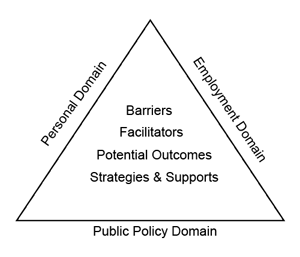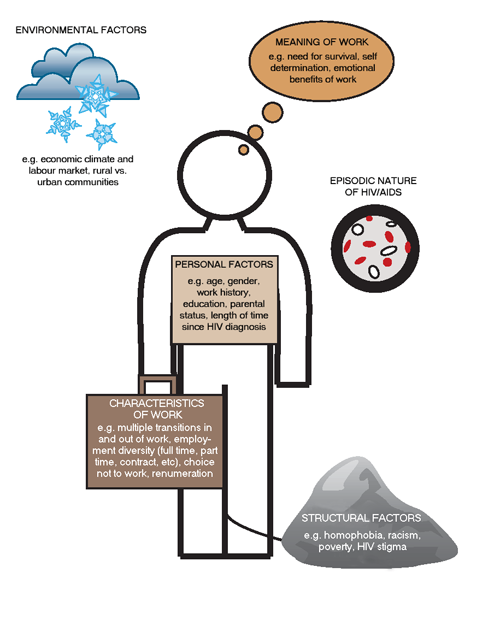A Framework to Enhance Labour Force Participation Options for People Living with HIV/AIDS in Canada
Introduction to the Framework
We have taken an integrated knowledge translation approach and built a study team of academic researchers and HIV community/decision-maker partners to develop resources to support effective labour force interventions for PHAs. Our study team set out to first develop a preliminary conceptual framework of labour force participation for people living with HIV (PHAs) in Canada. With operating grant funding from CIHR, we conducted a study with two primary objectives:
- To summarize existing knowledge, as well as gaps in knowledge, related to labour force participation for PHAs in Canada; and,
- To develop a labour force participation conceptual framework, consisting of facilitators and barriers of participation and key components to include in labour force participation initiatives from the perspective of people living with HIV, employers, insurers and policy makers.
The study was guided by a community advisory committee that included PHAs, AIDS service providers, private sector employers, and HIV policy makers. The research methods included a scoping review of published and grey literature, followed by consultation with key stakeholders. In developing the framework, investigators screened 11,165 abstracts, reviewed 243 full research articles and 42 reports (‘grey’ literature), interviewed 21 key stakeholders (PHAs, insurers, policy makers, service providers, employers) and conducted two focus group consultations with a total of 16 PHAs from diverse backgrounds.
This study was supported by a grant from the Canadian Institutes of Health Research (CIHR). For further information, contact the Canadian Working Group on HIV and Rehab (CWGHR) at info@hivandrehab.ca.
HIV and Employment Framework Overview
People living with HIV (PHAs) in Canada face significant challenges to participating in the workforce. We synthesized information from studies and consultations with stakeholders (including PHAs, employers, insurers and policy makers) to create a framework that shows key employment barriers and facilitators, potential outcomes of employment, and employment strategies and supports for people living with HIV. In the framework, we addressed these factors within personal, employment and public policy domains.

We screened 11,165 journal articles and report abstracts, and conducted a review on 285 selected documents to develop the preliminary framework. We then conducted 18 qualitative interviews and 3 focus groups (with a total of 34 participants) to augment the framework. The framework was also reviewed by members of a community advisory committee of those active in the HIV and employment fields.
We hope the framework provides useful information for PHAs, AIDS service organizations, vocational rehabilitation workers, employers, insurers, and policy makers as they work to develop options for labour force participation for PHAs. The next tab provides an overview of some of the key contextual factors that influence labour force participation, and the following tabs show details of barriers, facilitators, potential outcomes, and strategies and supports within the different domains (personal, employment and policy).
Broader Factors Influencing Labour Force Participation
Six key factors can influence (either facilitate or hinder) labour force participation for people living with HIV.

- Environmental factors such as economic climate and location of residence (urban versus rural) can impact the opportunities for and the ability of an individual to remain in or return to the workforce.
- Structural factors such as stigma and poverty can complicate the ability to participate in the work force.
- The episodic nature of HIV characterized by sometimes unpredictable periods of wellness and illness can further complicate the ability for someone to remain or return to work.
- Personal factors including age, gender, employment history, and level of education may facilitate or hinder the ability to work.
- Characteristics of work, such as transitioning in and out of the workforce, diversity of employment types (full time, part time, contract work), and remuneration will influence the ability to participate in the workforce.
- Finally, the meaning that individuals place on work, such as the need for survival, self determination, and the emotional benefits tied to work, can also influence the decisions surrounding labour force participation.
- Each of these contextual factors will influence the personal, employment and policy domains.
Personal Domain

Facilitators
INCOME MAINTENANCE
• Flexible disability and income supports
VOCATIONAL FACTORS
• Job characteristics (psychologically and emotionally rewarding jobs)
• Job skills, work experience and education
• Good work/individual matches
HEALTH FACTORS
• Improved health status
• Successful, stable access to HAART regimen
• Managed concurrent health conditions
MENTAL HEALTH FACTORS
• Self-awareness, assertiveness
SOCIAL FACTORS
• Instrumental social supports (peer support and case management)
• Stable partnership or family support
• Self-advocacy skills
• Access to community resources (childcare, transportation, legal, medical care)

Potential Outcomes
INCOME MAINTENANCE
• Increased or decreased income for PHAs
VOCATIONAL FACTORS
• Increased physical and cognitive stimulation
• Reduction in risk behaviours
HEALTH FACTORS
• Better perceived general health / Work stress leads to negative health effects
• Employment can lead to higher HRQOL among PHAs
• Slower disease progression / reduction in HIV symptoms
• Higher physical functioning / fewer physical limitations
• Less physical pain
MENTAL HEALTH FACTORS
• Increased sense of well being
SOCIAL FACTORS
• Decreased ability of PHAs to access community services
• Increased social participation
Strategies and Supports
PRE-WORK PREPARATION
• Support for well informed decision making including decision not to work
• Opportunities to develop job search skills: resume writing, interviewing
• Access to return to work training without risking benefits
• Support for career development and career change
• Defining ‘success’ in flexible terms
SUPPORTING RETURN TO WORK
• HIV-specific services
• Peer support
• Individualized approach
• Strengths-based approach
• Services provided by supportive, courteous and respectful professionals
• Facilitated adjustment to the workforce
• Opportunities for temporary and part-time work
• Services that allow PHAs to return to work in a way that best suits their financial and adjustment-related needs
• Holistic and process-oriented approach
• Emphasis on learning practical skills
• Encouragement to counter broader cultural messages re: illness and stigma
• Support for career advancement
SUSTAINING EMPLOYMENT
• Support for disclosure
• Off site vocational counseling: job-specific, problem solving, disability management, & coping skills
• Occupational therapy: workplace modification, training, energy conservation techniques
Key factors within the personal domain play a critical role in influencing labour force participation for PHAs. These may include income maintenance, vocational, health, mental health or social factors. Support at this level during all phases of the employment process is important in assisting PHAs to successfully achieve their vocational goals.
Employment Domain

Facilitators
DISABILITY IN THE WORKPLACE
• Policies to increase awareness and acceptance
• Self-advocacy training
• Vocational and employment services
• Access to information
WORKPLACE FACTORS
• Organizational cultures that value people with disabilities
• Workplace AIDS education and support programs
• Leadership / human resources champion
• Flexibility in the workplace
ACCOMMODATION FACTORS
• Workplace accommodations
• Government funded resources for employers
• Organizational structure: large
employers more able to accommodate

Potential Outcomes
DISABILITY IN THE WORKPLACE
• Negative response of clients and customers
• Decreased litigation
• Providing equity and raising morale
WORKPLACE FACTORS
• Improves organizational culture of
businesses
• Contributes to productivity, efficiency and success of organization
• Employer reputation as a responsible corporate citizen
• Attraction and retention of qualified
employees
ACCOMMODATION FACTORS
• Costs of accommodation
• Costs to employers of not accommodating employees
• Decreased productivity
• Possible attendance issues
Strategies and Supports
• Providing PHAs with informed mentors
• Initiatives to reduce discrimination
Key factors related to the employment domain may impact a PHA's ability to successfully participate in the labour force. Factors related to disability in the workplace, workplace conditions and accommodation all play a role in shaping the organizational context. Strategies to address these factors are important considerations when supporting PHAs in employment situations.
Public Policy Domain

Facilitators
INSURANCE BENEFITS
• Flexibility of disability income supports(transitional benefits, automatic reinstatement, and allowable earning amounts)
PROGRAMS & POLICIES
• Providing equity of access to community programs and resources
• Anti-discrimination legislation

Potential Outcomes
INSURANCE BENEFITS
• Cost savings for insurers
• Decreased costs for public income support programs
• Tax benefits
• Decreased burden on health and social service programs
PROGRAMS & POLICIES
• Promotes inclusive and diverse communities
Strategies and Supports
• Creation of networks of service providers: partnerships, coalitions
• Support for capacity building among networks of ASO’s and NGO’s
• Public education re: HIV and disability
• Legal supports
• Workplace prevention programs
• Increased involvement of labour unions
• Creation of HIV specific employment programs
• Support for anti-discrimination and anti-stigma work
Important factors within the public policy domain include those related to insurance benefits and programs and policies. Advocacy and intervention at this level are significant components of any effort to assist PHAs in successfully maintaining employment.
The factors outlined in the framework are part of a larger discussion on enhancing the successful workforce participation of PHAs in Canada. Front-line AIDS service organizations, people living with HIV/AIDS, employers and policy-makers all have critical roles to play in improving employment options for PHAs, and in building workforces that contribute to a healthier, more diverse and, ultimately, more productive society. |
|---|
